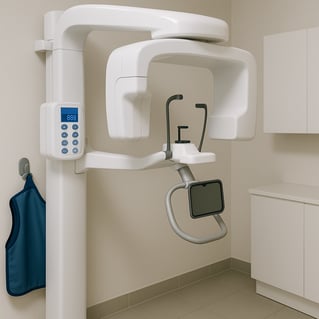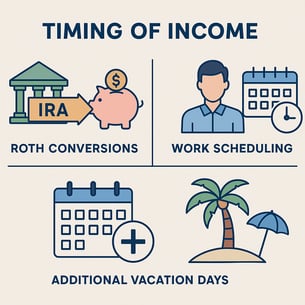High-earning practice and business owners often face hidden tax traps—what we call “tax torpedoes.” These “torpedoes” often strike whenever income crosses certain thresholds, which can suddenly reduce deductions or eliminate tax breaks altogether.
The two torpedoes every high-earning owner needs to watch closely are the state and local tax (SALT) deduction phaseout and the Qualified Business Income (QBI) deduction phaseout.
This post breaks down how they work and shares tips to plan ahead and reduce your tax rate.
The State and Local Tax (SALT) Deduction Phaseout (Torpedo #1)
The 2025 tax law temporarily increased the cap on the State and Local Tax (SALT) deduction to $40,000 for joint filers and $20,000 for single filers.
The "catch" is that you only get the full deduction if your income is below certain thresholds.
Once taxable income crosses $500,000 for joint filers (or $250,000 for single filers), the extra bonus phases out, and you’ll find the deduction shrinking.
By the time you reach $600,000 (joint) or $300,000 (single), you’re back down to the basic $10,000 cap.
How the SALT Phase Out Looks
As your income increases, the tax rate you pay isn't the same on the incremental dollars. It's easy to look at the tax bracket table and think you know the rates but that isn't how tax calculations work.
If you go above certain income levels, you lose out on deductions that you might otherwise receive if you made slightly less money.
Your effective tax rate jumps above 40% between $500K and $600K of taxable income as the increased SALT deduction disappears. In some cases, your added income is taxed at 45%, even though you are in the 32% bracket.

The Qualified Business Income Deduction Phaseout
The Qualified Business Income (QBI) deduction was written into law so business owners could write off as much as 20% of their business profit.
Although it was officially made permanent in the "One Big Beautiful Bill" Act in 2025, it’s still reduced if your income gets too high, especially if your work classifies as a “specified service trade,” which includes dentists, accountants, and high earning professions.
For married couples filing jointly, the deduction starts to drop once your taxable income hits around $400,000 (about $200,000 for single taxpayers). Once you go beyond $500,000 (or $250,000 for single), it can go to ZERO.
When you’re a business owner right near that threshold, the numbers can tilt dramatically and have a big impact on your tax bill.
Losing that 20% write-off isn’t small change; it can add up to tens of thousands in sudden, unexpected tax liability.
The QBI deduction vanishes between $400K and $500K of taxable income (joint), which sends your effective tax rate higher.

Effective Strategies to Minimize Your Tax Rates

Strategy 1: Equipment or Business Purchases
Upgrading imaging machines, chairs, or any essential equipment is part running an efficient business, but it can also be wise tax planning. You get to write off these costs, but timing is key to maximizing tax savings. As an owner, your business decisions and personal tax are very connected.
You can also write off the purchase of a business if you bought the assets of a business or practice.
The two methods to create a business expense from your equipment purchase are:
-
Section 179 Deduction: You can write off the whole cost of qualifying equipment, up to a set annual limit, the moment you buy it. You also have the option to spread the deduction out over time if that benefits you more.
Bonus Depreciation: This feature lets you deduct 100% of the purchase in the purchase year, with fewer eligibility hoops and less flexibility.
If you want to spread out the deduction, use Section 179. If it all needs to go in one year, bonus depreciation is a great pick.
Side note: buy the equipment because it makes business or economic sense, not just for the tax break.
Strategy 2: Shift Income or Expenses Across Years
One of the easiest ways to lower your tax bite is to control when you receive money:
-
Roth Conversions: Moving money from a regular IRA to a Roth account can be a smart move, but it increases your taxable income in the year you do it. Pick the year carefully.
Work Scheduling: Sequence the start of treatment, contracts, or events to manage which calendar year the income gets taxed in. Would you rather pay 45% tax on the income this year or 24% the next year could be a decision you consider at the end of the year.
Go on vacation: It's an odd suggestion but if you've had an excellent year, you may consider taking some valuable time off rather than getting hit with a tax torpedo.
Strategy 3: Dial Up 401(k) or Defined Benefit Plan Contributions
Saving more money into retirement accounts can cut your taxable income and builds your personal savings.
-
Use a 401(k) with Profit Sharing: These plans let you defer money from your paycheck and add a profit-sharing sharing contribution on top. It's one of the few tools you can use after the calendar year is over to lower your taxable income. You can wait to decide until September of the next year if you have the right plan.
-
Add a Cash Balance Plan: A cash balance plan normally works well for owners closer to retirement and allows much higher contributions than a 401k. Sometimes you can contribute $100's of thousands to a cash balance plan.
These accounts are normally a slam dunk for business and practice owners because they allow for future savings and current year tax breaks. It is also a great retention tool for staff and employees that value total compensation.
Why Tax Projections Matter More for Owners this Year
New tax rules make “guessing” your taxable income almost impossible this year. There are so many moving parts, we utilize professional software to create a tax estimate.
For owners, you need a high-quality forecast of the business profit that includes a conversion of "book" income to tax. Tax based forecasts actually allow you to estimate the tax liability from your business before the year ends.
📅Plan ahead to avoid tax torpedoes!
JE Simmons partners with high-earning business and practice owners to build those detailed tax projections and get ahead of the game. Most CPAs are great at recording the past but fail to plan years in advance.
With the right planning, you can lower your lifetime tax rate and keep more of your hard-earned money.
The best way to get started with us is with a phone call. Please book below so we can talk to you about your year-end tax projection.

